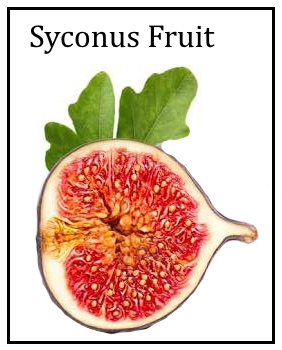
Immature fig or gular fruit is a
(a) Berry
(b) Syconus
(c) Samara
(d) Pepo
Answer
482.1k+ views
Hint: This is a type of inflorescence which is borne by figs and formed by an enlarged, fleshy, hollow receptacle that has multiple ovaries on the inside surface.
Complete answer:
Immature fig or gular fruit is a syconus. It is a fleshy stem with several flowers, so it is considered both a multiple and accessory fruit. It is a type of composite fruit formed from a hollow fleshy inflorescence stalk inside which tiny flowers develop.
The syconium is an urn-shaped receptacle that contains between 50 and 7000 depending on the species. They are highly simplified ovulate flowers or florets on its inner surface. It is closed faraway from most organisms by the ostiole, fringed by scale-like bracts.
Additional Information:
Syconia can be monoecious or functionally dioecious. The Monoecious contain female flowers with variable style length and few male flowers and produce seeds and pollen. Whereas the dioecious have male and female forms in different plants: seed figs contain female flowers with long styles and produce seeds; gall figs contain female flowers with short styles and male flowers and produce pollen.
The syconium is thought to have first evolved 83 million years ago in the Cretaceous from an entomophilic clade including the tribe Castilleae and genus Ficus, as the bracts protecting the inflorescence tightened to make the ostiole, greatly increasing the pollinator specificity of the plant and initiating an extended and sophisticated history of coevolution between figs and their pollinating wasps.

So, the correct answer is, ’Syconus’.
Note: -After pollination is done, the florets develop into achenes or drupes, in which the seeds are enclosed by a layer of the endocarp. From this attitude, the fig is an enclosure with tens to thousands of fruits within it.
-The formation of the syconium begins with the initial growth of bracts, which curve to form a receptacle. When the outer bracts meet, they form the ostiole by the interlock. Syconia can also develop lateral, basal, or peduncular bracts. There is a relationship between the form of the ostiole and therefore the morphology of the pollinating wasp.
Complete answer:
Immature fig or gular fruit is a syconus. It is a fleshy stem with several flowers, so it is considered both a multiple and accessory fruit. It is a type of composite fruit formed from a hollow fleshy inflorescence stalk inside which tiny flowers develop.
The syconium is an urn-shaped receptacle that contains between 50 and 7000 depending on the species. They are highly simplified ovulate flowers or florets on its inner surface. It is closed faraway from most organisms by the ostiole, fringed by scale-like bracts.
Additional Information:
Syconia can be monoecious or functionally dioecious. The Monoecious contain female flowers with variable style length and few male flowers and produce seeds and pollen. Whereas the dioecious have male and female forms in different plants: seed figs contain female flowers with long styles and produce seeds; gall figs contain female flowers with short styles and male flowers and produce pollen.
The syconium is thought to have first evolved 83 million years ago in the Cretaceous from an entomophilic clade including the tribe Castilleae and genus Ficus, as the bracts protecting the inflorescence tightened to make the ostiole, greatly increasing the pollinator specificity of the plant and initiating an extended and sophisticated history of coevolution between figs and their pollinating wasps.

So, the correct answer is, ’Syconus’.
Note: -After pollination is done, the florets develop into achenes or drupes, in which the seeds are enclosed by a layer of the endocarp. From this attitude, the fig is an enclosure with tens to thousands of fruits within it.
-The formation of the syconium begins with the initial growth of bracts, which curve to form a receptacle. When the outer bracts meet, they form the ostiole by the interlock. Syconia can also develop lateral, basal, or peduncular bracts. There is a relationship between the form of the ostiole and therefore the morphology of the pollinating wasp.
Recently Updated Pages
Master Class 11 Accountancy: Engaging Questions & Answers for Success

Glucose when reduced with HI and red Phosphorus gives class 11 chemistry CBSE

The highest possible oxidation states of Uranium and class 11 chemistry CBSE

Find the value of x if the mode of the following data class 11 maths CBSE

Which of the following can be used in the Friedel Crafts class 11 chemistry CBSE

A sphere of mass 40 kg is attracted by a second sphere class 11 physics CBSE

Trending doubts
10 examples of friction in our daily life

Difference Between Prokaryotic Cells and Eukaryotic Cells

One Metric ton is equal to kg A 10000 B 1000 C 100 class 11 physics CBSE

State and prove Bernoullis theorem class 11 physics CBSE

What organs are located on the left side of your body class 11 biology CBSE

Define least count of vernier callipers How do you class 11 physics CBSE




